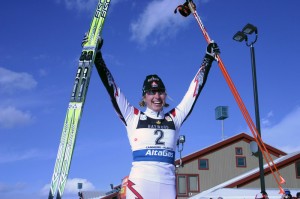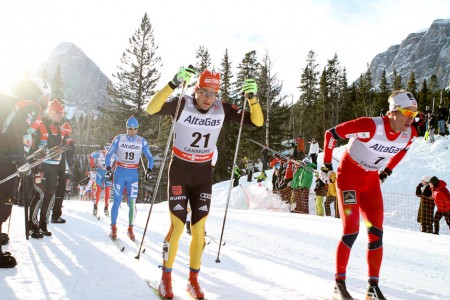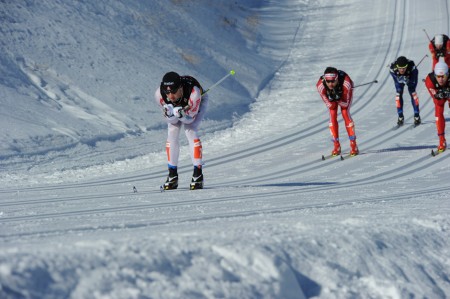Coverage of the Alberta World Cup made possible through the generous support of Travel Alberta and Tourism Canmore.
Click here for a video of the new sprint course (embedded below)
CANMORE, Alberta — When Hanna Falk of Sweden kicks off Saturday’s freestyle sprint qualifier, she will christen the third course variation in as many events.
Back in 2008, hometown favorite Chandra Crawford won the race on a loop that Canmore’s current chief of competition Mike Norton described as “way too short and too easy.”
In 2010, the sprint was classic, and that course came in at the other end of the spectrum. Post-season surveys yielded a consistent response from athletes — too long, and according to Norton, “hard.”
For this year’s edition, changes were necessary, both due to homologation standards and the desire of organizers to put on a top-notch event.
After examining data on other World Cup sprint courses, Norton said the decision was made to make the Canmore version harder and longer than 2008, but shorter than 2010.

The loop climbs fairly steadily out of the stadium to a high point, and a table-top flat, before descending to the classic Canmore finish — fast downhill to the homestretch.
The total length is 1.3k, longer than the 2012 1.2k World Cup average that Norton calculated, but definitely not one of the longest.
“I’ve had a couple athletes say it was the hardest short sprint course they’ve ever done,” Norton said.
A NorAm event just two weeks ago served as test-run, and with the presence of the top Canadian domestic racers and the Switzerland’s sprint squad, competition was appropriately fierce, and Norton said athlete response was positive.
The 2010 version featured two 180-degree turns, both of which have been removed, hopefully resulting in fewer tangles and crashes while creating better flow.
U.S. Ski Team coach Matt Whitcomb expects the course to ski “really fast,” with the working time from the start to the descent being “really short.”
But Whitcomb cautions not to discount the difficulty. He describes the first climb out of the stadium as “deceptively difficult,” and points to the technical aspects of several sharp corners as an added challenge.
Norton confirmed the potential for brevity, noting that that course “doesn’t have a lot of total climb,” just 37 meters in fact.

It isn’t all about climbing, however. The top of the course, which features several hundred meters of flat before skiers can gain a little respite prior to a sweeping right-hand turn under a bridge.
“The legs will be feeling it at the top of that course,” said Esther Bottomley, an Australian who has spent time training in Canmore and raced the NorAm two weeks ago.
“If you’ve gone too hard up the climb and can’t ski hard on the flat section before dropping back down…you could lose a lot of time,” Bottomley added.
The run-in to the homestretch, however, is still the key.
Whitcomb hesitated to make predictions, but agreed that the descent and ensuing 200 meters would be the crux.
“I would have to say it will probably be won or lost in the final homestretch,” he said.
Norton said many people state that whomever has the fastest skis will rule the day, a claim he disagrees with.
The Swiss men were able to ski away on the climbs, creating an insurmountable gap in the NorAm race, and with a gradual grade up to the finish line, Norton says it isn’t only about skis.

“Even the fastest skis in the world, you still have to work to get up that last 100 meters,” he said, but did admit that it’s “not ideal.”
A World Cup race is not a NorAm, so breaking away will be much harder. Whitcomb points to the myriad strategies that can be employed approaching the final third of the race.
“There are some awesome tactics to be found on this final stretch here,” he said, specifically mentioning the varying options of line through the last corner, and when to pull out of a tuck.
U.S. coaches have worked with athletes individually to discuss tactics. Each skier has certain strengths and weaknesses that will influence approach, Whitcomb explained.
And ultimately, racers need to respond to the immediate situation.
“You can come up with all these plans and sometimes you end up with the one you planned on, and sometimes it is the opposite of what you planned on,” Whitcomb said.
There is danger in trying to execute a specific strategy at all costs, and the key, Whitcomb said, is envisioning various scenarios and being prepared for all of them.
“There is a lot to think about here. It is a really good course … really fun,” Whitcomb said.
— Alex Matthews contributed reporting
Note: Some web browsers are not displaying the video properly. Use the link below to view the video directly in youtube.



